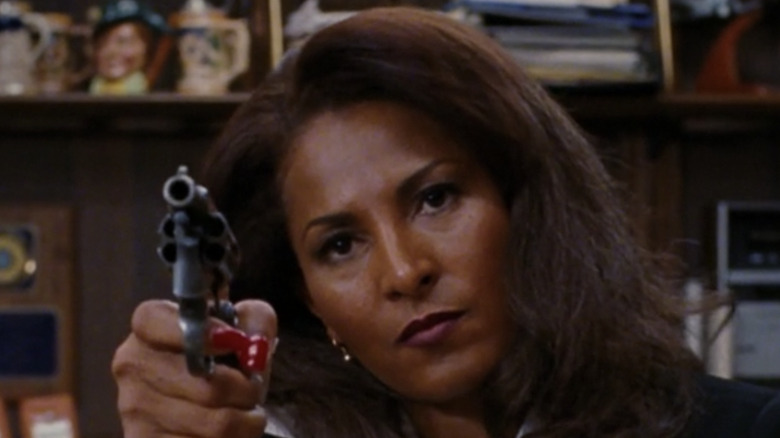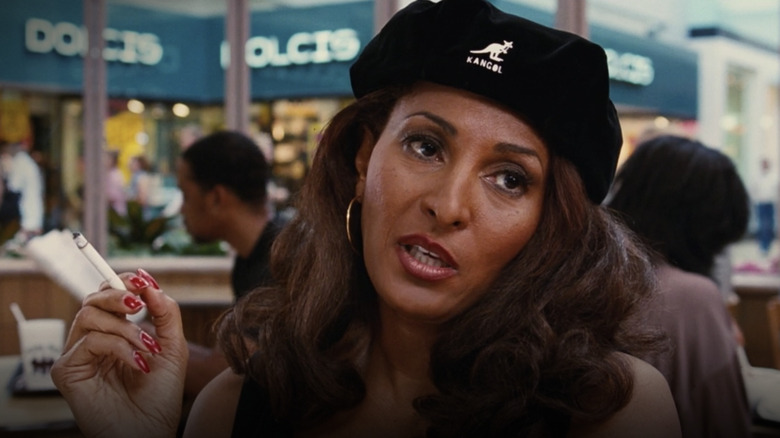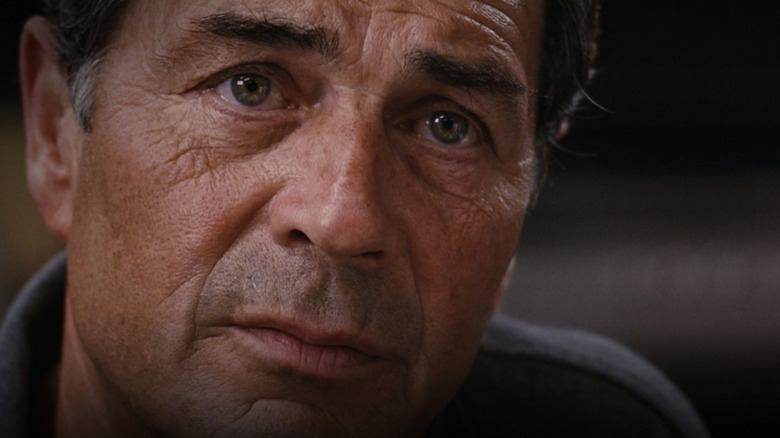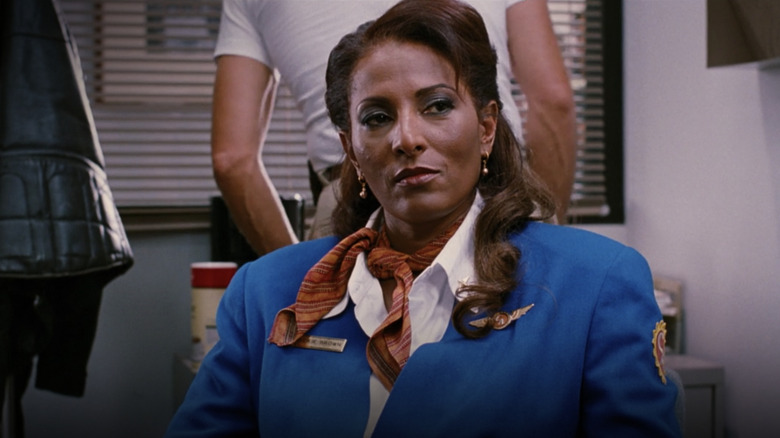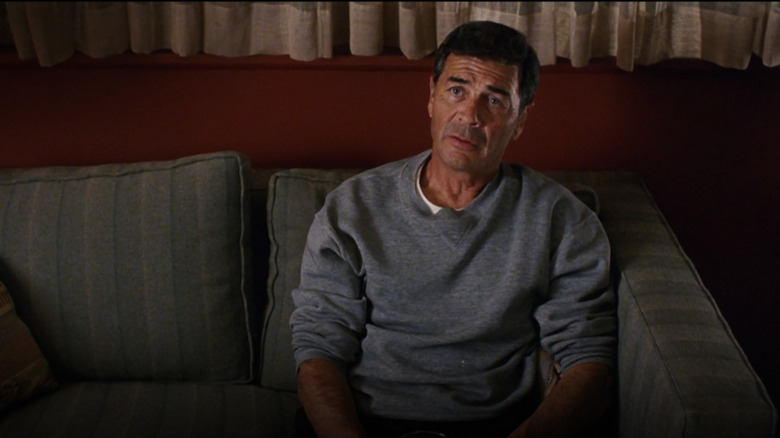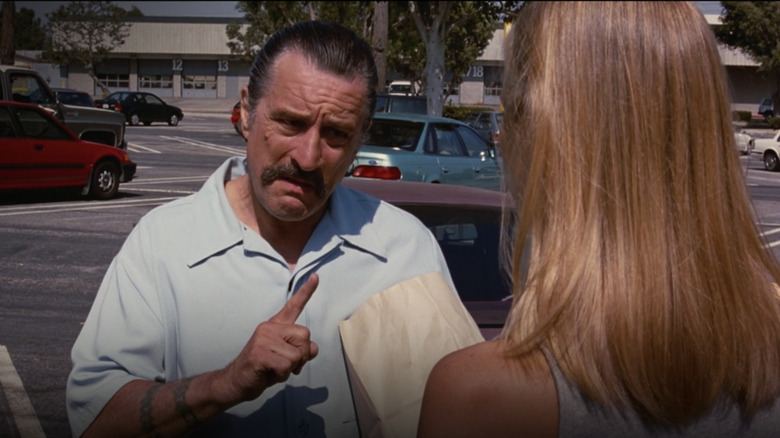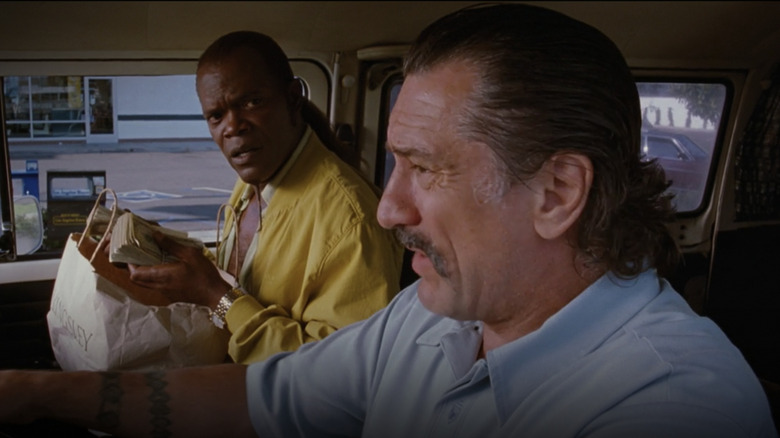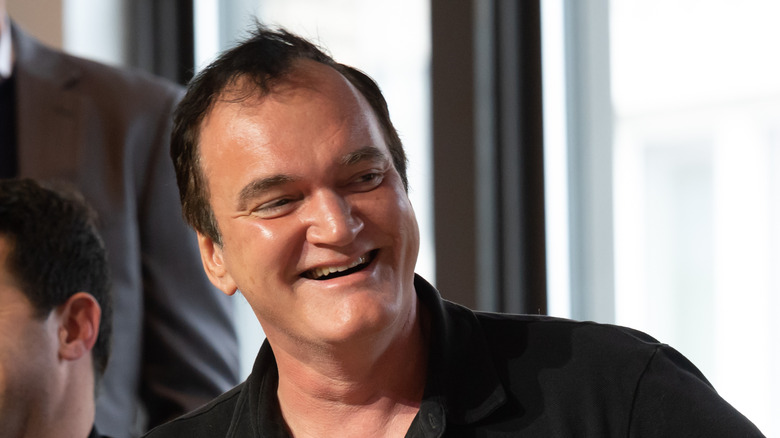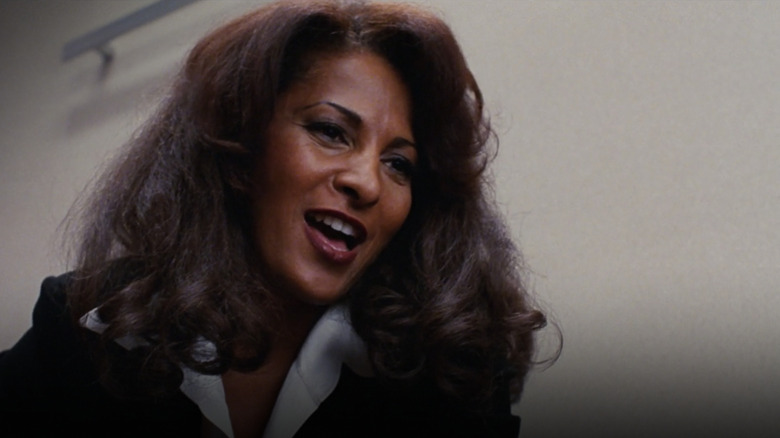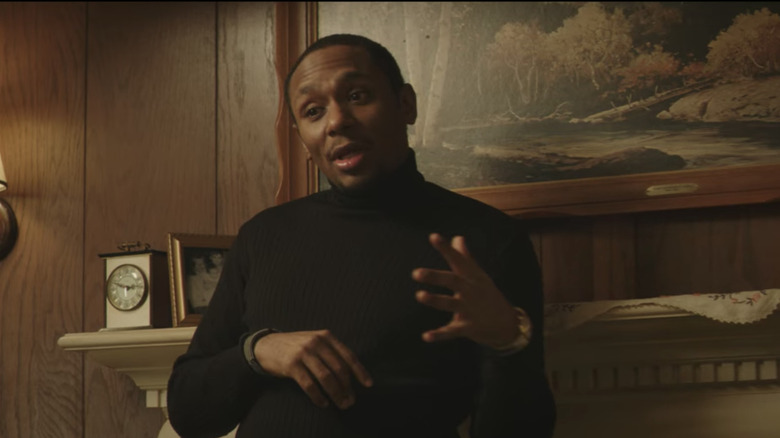The Untold Truth Of Jackie Brown
Quentin Tarantino's 1994 film "Pulp Fiction" landed like a bomb in arthouse theaters and multiplexes across the country. The fast-paced, terminally cool, and chronologically jumbled crime drama was a critical and commercial smash. It elevated the stardom of leads Samuel L. Jackson and Uma Thurman, introduced John Travolta to a new generation of fans, and made the 31-year-old writer-director a household name.
Everyone wanted to know what Tarantino would do next. In the years following "Pulp Fiction," there was a spate of postmodern crime thrillers made in its mold, hyperverbal and hyperviolent, with soundtracks full of AM radio hits and scenes packed with kitschy Gen-X nostalgia. What could Tarantino do when his own style had been so quickly aped and turned into cliche?
The answer was, something unexpected. In December of 1997, Tarantino released "Jackie Brown," an adaptation of novelist Elmore Leonard's "Rum Punch" inspired by 1970s blaxploitation films. Genre veteran Pam Grier was cast in the title role — a middle-aged flight attendant who gets caught between a gun-runner and the feds and must outwit everyone to stay alive and out of jail. The film received overwhelmingly positive reviews, if not quite as ecstatic as the ones that greeted "Pulp Fiction." Over the years, however, it has come to stand out as both one of Tarantino's greatest films and one of the best screen adaptations of Leonard's work. Here are some things you might not know about "Jackie Brown."
Which book?
According to the extensive DVD documentary "Jackie Brown: How It Went Down," Tarantino and his producing partner Lawrence Bender originally optioned three Elmore Leonard novels for development after the success of "Pulp Fiction." Those books were 1992's "Rum Punch" — the sequel to Leonard's kidnapping caper "The Switch" — the 1970s-set bomb thriller "Freaky Deaky," and the hitman drama "Killshot." "Freaky Deaky" was originally set to be a comeback gig for acclaimed '70s director Monte Hellman. Both it and "Killshot" would eventually be made in the 2000s without Tarantino's involvement.
"Rum Punch," of course, was different. Tarantino had actually read an advance copy of it while he was writing "Pulp Fiction." In a 1997 interview with Charlie Rose, he talked about reading the novel and seeing the film adaptation he would direct in his head, even making note of actors who would be good for different parts. Legal issues kept him from optioning the novel before it was published in 1992, but after "Pulp Fiction," the book caught Tarantino's attention once again. "I just read it again, just to read it," he told Rose. "And that same movie [that he had imagined] came back in front of me again. And I was like, 'That's a sign. I want to do this.'"
Tarantino's adaptation
Of course, the movie in Tarantino's head didn't always match up with what Leonard wrote. In adapting "Rum Punch," he made several significant changes to the novel. The script switches out the book's Miami setting — a frequent Leonard locale — for Los Angeles, focusing primarily on South Bay suburbs like Hawthorne and Carson, sports bars by the airport, nondescript Hollywood apartment complexes, and other less glamorous parts of the city. Low-rent arms dealer Ordell Robbie (Samuel L. Jackson) is no Scarface; he has no palatial estate with guards at the ready, just a handful of houses and apartments for his mistresses around town that he splits his time between. In fact, part of the charm of Jackson's Golden Globe-nominated performance is the distance between Ordell's bravado and his relatively humble circumstances.
With the Miami locale gone, the novel's Florida cocktail of a title had to go too. In its place, Tarantino used the name of his lead character. Leonard's novel starred a character named Jackie Burke, a white 40-something flight attendant who was smart, suave, and three steps ahead of everyone else. Tarantino kept many of those traits intact, noting to Charlie Rose that while nearly any other adaptation would have made her younger, her age was key to the character for him. His Jackie was still a 40-something flight attendant and the smartest person in any given room, but her race and surname were both changed.
From Foxy to Jackie
In his interview with Charlie Rose, Tarantino said that he didn't have any particular actor in mind when it came to Jackie at first. But when considering the character's cool factor, her savvy, and her resiliency, there was only one choice. "It sounds like Pam Grier," he said. "That's what Pam Grier could do. That's what Pam Grier does."
In the 1970s, Grier was the queen of the blaxploitation genre. Her films "Coffy," "Foxy Brown," "Sheba, Baby," and the comic strip adaptation "Friday Foster" are classics of the era, combining hard-hitting action and occasionally gruesome violence with relevant social commentary about the Black American experience and the dangers women face in their everyday lives. As the '70s turned to the '80s, the golden age of blaxploitation films faded, and Grier's career shifted. She continued to work steadily in the '80s and '90s, but she didn't enjoy her previous marquee status.
Still, Grier retained many dedicated fans, including Tarantino himself. The director told Charlie Rose that he ran into Grier at an awards show as he was finishing up the "Jackie Brown" screenplay and told her that he was writing a part for her. He then mailed her the script, but as Grier would later tell the Cleveland Plain Dealer, he neglected to pay the correct postage, causing the delivery to be delayed by three weeks. After paying the correct postage (44 cents), Grier finally got a chance to read the script that would become one of her most successful films and help revitalize her career in Hollywood.
Casting to and against type
Grier was not the only actor in "Jackie Brown" whose career had declined after a peak in the 1970s. Character actor Robert Forster had starred in Haskell Wexler's 1969 X-rated political drama "Medium Cool" and the 1973 mob movie "The Don is Dead," but in later years he was mostly found in bit parts on television and in lower-budget films like the 1996 blaxploitation throwback "Original Gangstas," which also happened to star Pam Grier. Like her, Forster was given the "Jackie Brown" script personally by Tarantino after running into him at the Silver Spoon diner in Hollywood. Tarantino mentioned that he was adapting "Rum Punch" and that Forster should read it. "Six months later," Forster told Variety in 2017, "I walked into the Silver Spoon and he was sitting in my spot with the script."
Max Cherry, a capable but world-weary bail bondsman, was written with Forster's strengths in mind: Laconic, no-nonsense, but with a soft side. Samuel L. Jackson and Bridget Fonda were similarly cast to type, with Jackson bringing the profane charisma that had made him a breakout star in "Pulp Fiction," and Hollywood scion Fonda cutting through the pretense as California beach bunny Melanie. Conversely, it was a bit of a surprise at the time to see acting legend Robert De Niro in a comedic supporting role as Ordell's drug-addled ex-con partner Louis Gara.
A movie lover's soundtrack
Music has always been a big part of Tarantino's creative process, and many of the most memorable moments in his films are centered around the songs he picks. From Mr. Blonde torturing a police officer to the tune of "Stuck in the Middle with You" in "Reservoir Dogs" to Dick Dale's immortal surf-rock classic "Miserlou" ushering in "Pulp Fiction," the music is always key. In both of those films, Tarantino eschews a traditional written score in favor of a wall-to-wall soundtrack of 1960s pop hits, soul classics, and AM radio gold.
For "Jackie Brown," he implemented a similar strategy, but with a twist. The soundtrack comes with his standard-issue nostalgia bait selections like "Midnight Confessions" by The Grass Roots and a range of 1970s R&B classics by the likes of Brothers Johnson, Minnie Riperton, and The Delfonics. However, Tarantino also included specific songs and scores from the blaxploitation films that inspired "Jackie Brown." The film's opening credits sequence of Jackie walking through LAX to her flight attendant job is scored to Bobby Womack's "Across 110th Street," which was written and recorded for the 1972 crime drama of the same name. A selection of Roy Ayers' score from Pam Grier's 1972 hit "Coffy" plays prominently in the heist sequence at the Del Amo Mall, and Grier herself even appears on the soundtrack, singing lead vocals on the song "Long Time Woman" from her 1971 women's prison film "The Big Doll House."
Real money
The plot of "Jackie Brown" revolves around $550,000 in cash owed to Ordell. Jackie has been smuggling his gun-running cash from Mexico piecemeal via her job at Cabo Air for some time, but when federal agents (led by Michael Keaton's Ray Nicolette) start sniffing around, Jackie convinces Ordell to bring the rest of it, over half a million dollars, all at once. Of course, she ends up secretly working with Nicolette to catch Ordell, while hatching a third plan to keep all the money for herself.
These plotlines come together in a brilliant heist sequence at the Del Amo Mall. Tarantino plays out the scene from one character's perspective first, then rewinds to show two different angles, giving the audience the full details of how Jackie pulled her plan off. At the center of the sequence is a shopping bag full of cash, but rather than using prop money — which must be recognizably fake in order to avoid violating federal counterfeit laws – Tarantino decided he wanted the real thing. In the "How It Went Down" DVD documentary, prop master Steve Joyner shows the result off to the behind-the-scenes camera crew — stacks of actual hundred-dollar bills stuffed into a cardboard box for storage. "If you ever wanted to know, that's what a half a million dollars feels like," he says, shaking the box for effect.
A life in the theater
After "Jackie Brown" was released in December 1997, Tarantino spent weeks at the Magic Johnson Theater in Los Angeles, watching the film over and over again with audiences and paying close attention to their reactions at different points. In a wide-ranging interview conducted for the "Jackie Brown" DVD release, he talks about those audience reactions and how they often varied across lines of age and race. The slow-burn romance between Jackie and Max (who, as he notes, have a combined age of over 100) apparently turned off some younger fans, but Tarantino says that he didn't make the film for that demographic.
"I really kinda made it for Black audiences," he explains in the interview. "Everyone else is invited, right, but I made it for Black audiences." As an example of a scene that audiences reacted to quite differently, Tarantino describes the moment when Max picks Jackie up from jail. The shot is staged with her walking toward Max down a long hallway — the "Omar Sharif shot," as Tarantino calls it in the interview, referring to that actor's famous entrance in "Lawrence of Arabia." The scene is scored with the Bloodstone song "Natural High," and Tarantino says his intention was simply to create a "great movie moment" centered on Grier's natural star power. However, he says that white audiences perceived the scene differently, understanding the song as a reflection of Max's internal monologue as he falls in love with Jackie — something Tarantino himself never intended to convey.
Oscar snubs and revitalized careers
"Jackie Brown" was critically praised, but it was a minor commercial hit compared to "Pulp Fiction." The film garnered some awards attention, including Golden Globe nominations for Grier and Jackson, but it was snubbed by the Academy Awards in every category but one — a Best Supporting Actor nomination for white star Robert Forster. Nevertheless, the film provided something arguably even better than awards recognition: A second act in the careers of two great actors, Forster and Grier.
After "Jackie Brown," Grier starred in the barroom sitcom "Linc's" from 1998 to 2000 and the lesbian-centered drama "The L Word" from 2004 to 2009. She also featured in the short-lived 2019 ABC sitcom "Bless This Mess" with Dax Shepard and Lake Bell. Additionally, Grier has made dozens of guest appearances on shows like "Law and Order: Special Victims Unit," "Smallville," and "This Is Us," along with roles in films like "Ghosts of Mars," "Larry Crowne," and "Just Wright."
Forster kept similarly busy after "Jackie Brown," taking film and TV roles that played to his reclaimed image as a soft-spoken tough guy. He became a favorite of director David Lynch, with appearances in 2001's "Mulholland Drive" and 2017's "Twin Peaks: The Return." One of his more notable appearances in the 2010s was as Ed "the disappearer" in the "Breaking Bad" franchise. Speaking to Variety about "Jackie Brown" in 2017, Forster said that he and Grier "got a shot at a career again" after starring in Tarantino's film. "It's nice to have grabbed a warm streak near the end of your career," he said.
The prequel you may not have seen
The 1990s were a boom time for quality film adaptations of Elmore Leonard's work, with "Jackie Brown," Barry Sonnenfeld's "Get Shorty," and Steven Soderberg's "Out of Sight" (in which Michael Keaton reprised his Ray Nicolette role for a quick cameo) leading the pack. The trend continued in the 2000s and 2010s, with some (like classic Western film "3:10 to Yuma" and neo-Western series "Justified") better than others (like the "Get Shorty" sequel "Be Cool" and 2004's "The Big Bounce").
In 2013, writer-director Daniel Schechter adapted Leonard's 1978 novel "The Switch" into the film "Life of Crime." "The Switch" is the predecessor to "Rum Punch" and follows Ordell Robbie and Louis Gara on a kidnapping caper gone awry. As such, "Life of Crime" is a prequel of sorts to "Jackie Brown." Wisely, Schechter avoids any direct comparisons or references to Tarantino's film, content to let "Life of Crime" be its own thing — a clever bell-bottoms-and-big-cars retro crime comedy. Yasiin Bey and John Hawkes play the younger Ordell and Louis, respectively, with Isla Fisher on hand as Melanie and Tim Robbins as the rich man being extorted. Jennifer Aniston shines as the obnoxious kidnappee, a bored housewife who is already furious at being abducted before discovering that her husband is in no hurry to get her back. It's a fun film in its own right that earned solid reviews, and it's definitely worth a watch for "Jackie Brown" fans.
